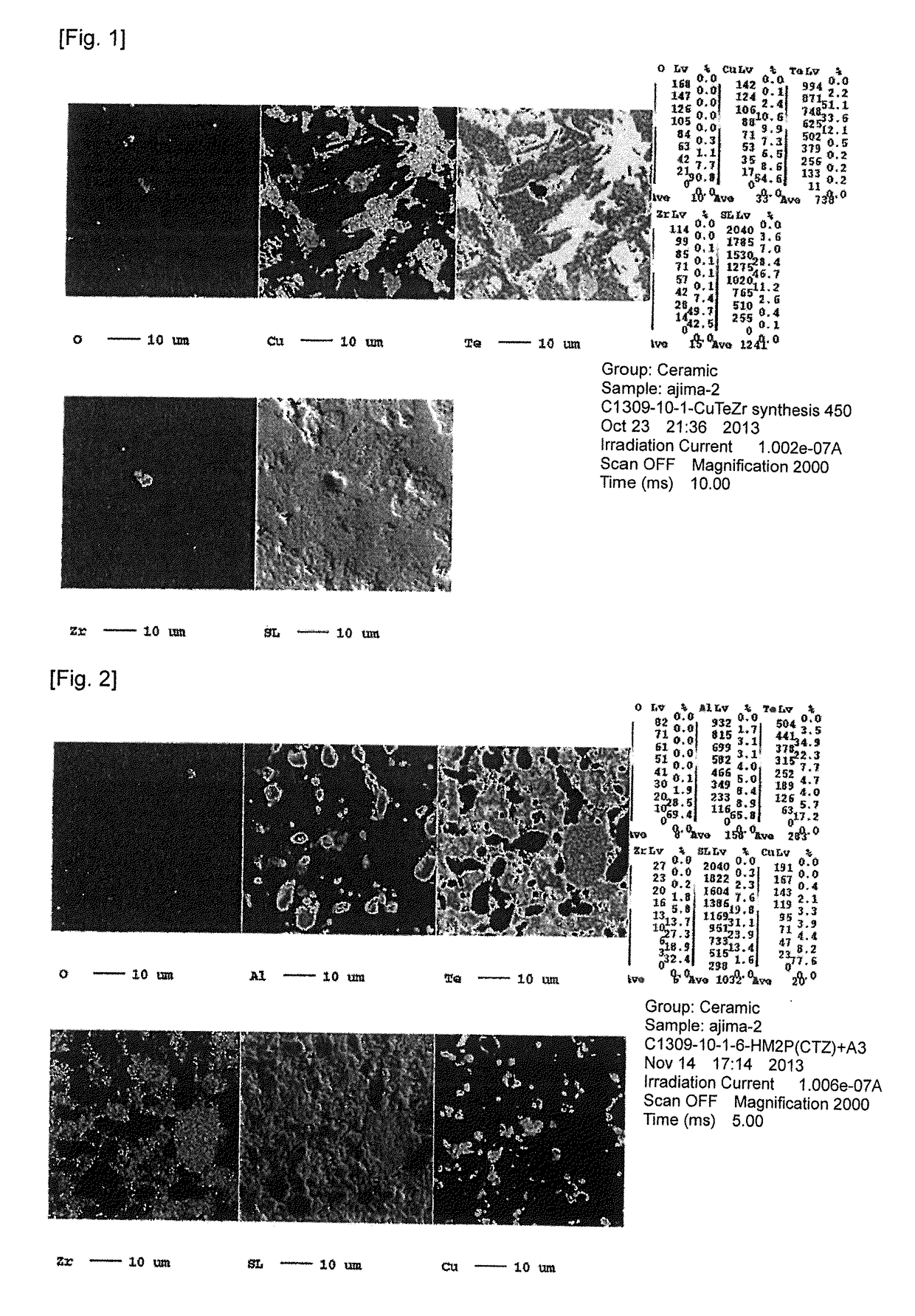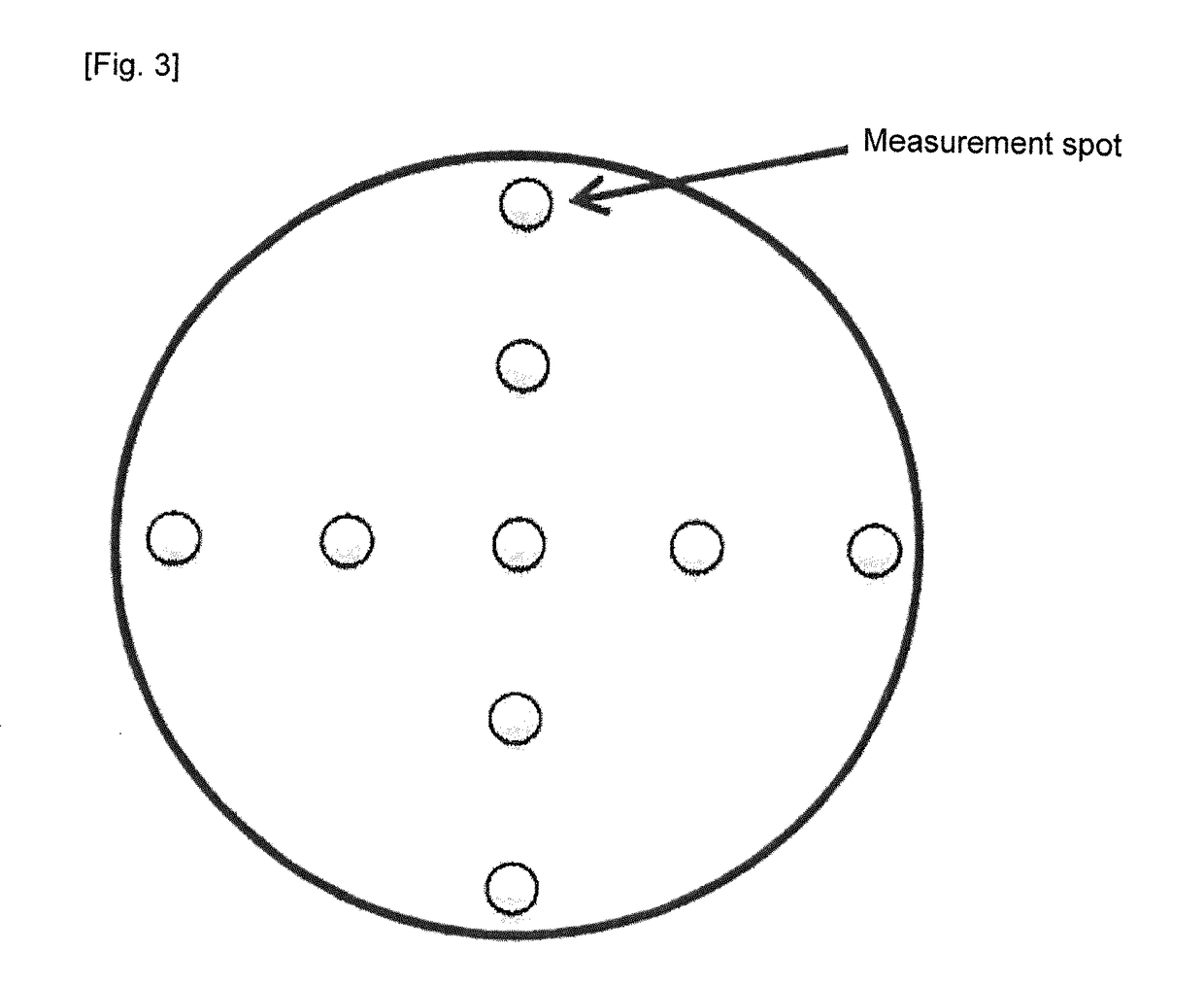Sputtering Target Comprising Al-Te-Cu-Zr Alloy, and Method for Producing Same
a technology of zr alloy and sputtering target, which is applied in the direction of vacuum evaporation coating, coating, electric discharge tube, etc., can solve the problems of large amount of particle generation, large amount of nodules, and high reactive al-te, and achieve large sputtering rate, uniform deposition rate, and small sputtering rate
- Summary
- Abstract
- Description
- Claims
- Application Information
AI Technical Summary
Benefits of technology
Problems solved by technology
Method used
Image
Examples
example 1
[0032]A Cu raw material with a purity of 4N and a Te raw material with a purity of 5N were weighed out to give a composition of Cu:Te=30:70 (at %). A Cu wire rod and a Te shot sized for a synthesis ampule were selected as raw materials. Then, the raw materials were charged into a high-purity quartz ampule and vacuum-sealed to prevent oxidation and contamination from the environment during dissolution. An ampule with an inner diameter of 80 mm and a length of 200 mm was selected and used so as to obtain a homogeneous temperature distribution and a uniformly mixed molten metal. Then, dissolution was performed to obtain an alloy. The temperature was maintained at 1000° C. for 4 hours to ensure that Cu and Te are thoroughly reacted and dissolved. During this process, a molten metal was allowed to oscillate at a frequency of 30 Hz for homogenization. After dissolution was completed, the content was cooled slowly to room temperature in the furnace to produce a cast ingot. A highly pure Cu...
example 2
[0037]A sintered compact was produced under similar conditions as in Example 1 except that the temperature (maximum) when sintering a mixture of a CuTe powder and a Zr powder was changed to 500° C. (liquid phase reaction) from 400° C. An Al—Te—Cu—Zr alloy sintered compact with a purity of 3N or more, an oxygen concentration of 2900 wt. ppm, a relative density of 93% and a mean grain size of 9 μm was obtained in a way as described above. Observation showed that the sintered compact had a structure comprising an Al phase, a CuAl phase, a TeZr phase and a Zr phase. Then, this sintered compact was machined to produce a sputtering target, with which sputtering was performed under similar conditions as in Example 1. Results showed that the number of particles (0.2 μm or more) was as extremely low as 18.
example 3
[0038]The CuTe powder with a grain size of 90 μm or less which was produced in Example 1 was further pulverized with a jet mill. The maximum grain size after pulverization was 5 μm, and the content of oxygen was 680 wt. ppm. Then, hydrogen reduction was performed under the same conditions as in Example 1 to obtain a low-oxygen powder with an oxygen concentration of 80 wt. ppm. The resulting CuTe powder with a maximum grain size of 5 μm and an oxygen concentration of 80 wt. ppm, an Al powder with a maximum grain size of 10 μm and an oxygen concentration of 5100 wt. ppm and a Zr powder with a maximum grain size of 10 μm and an oxygen concentration of 8000 wt. ppm were weighed out and mixed to give the same composition as in Example 1. The resulting raw material powder was charged into a graphite die with a diameter of 480 mm, and hot-pressed to produce a sintered compact. As in Example 1, the sintering conditions were such that the sintering temperature was 325° C., the pressing press...
PUM
| Property | Measurement | Unit |
|---|---|---|
| Grain size | aaaaa | aaaaa |
| Temperature | aaaaa | aaaaa |
| Temperature | aaaaa | aaaaa |
Abstract
Description
Claims
Application Information
 Login to View More
Login to View More - R&D
- Intellectual Property
- Life Sciences
- Materials
- Tech Scout
- Unparalleled Data Quality
- Higher Quality Content
- 60% Fewer Hallucinations
Browse by: Latest US Patents, China's latest patents, Technical Efficacy Thesaurus, Application Domain, Technology Topic, Popular Technical Reports.
© 2025 PatSnap. All rights reserved.Legal|Privacy policy|Modern Slavery Act Transparency Statement|Sitemap|About US| Contact US: help@patsnap.com


